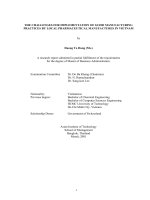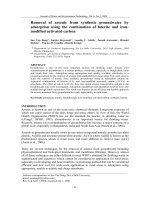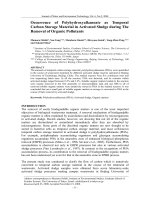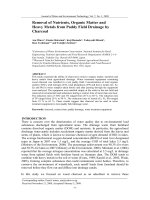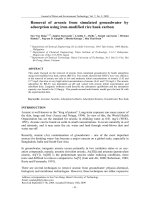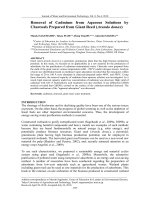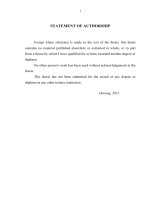Removal of trace organic contaminants by integrated membrane proc
Bạn đang xem bản rút gọn của tài liệu. Xem và tải ngay bản đầy đủ của tài liệu tại đây (2.56 MB, 171 trang )
University of Wollongong
Research Online
Removal of trace organic contaminants by
integrated membrane processes for indirect potable
water reuse applications
Abdulhakeem Alturki
University of Wollongong
School of Civil, Mining and Environmental Engineering
Removal of Trace Organic Contaminants by Integrated Membrane
Processes for Indirect Potable Water Reuse Applications
Abdulhakeem Alturki
This thesis is presented as part of the requirements for the
award of the Degree of the Doctor of Philosophy
University of Wollongong
January, 2013
i
CERTIFICATION
ii
ABSTRACT
The occurrence of trace organic contaminants (TrOCs), both from anthropogenic and
naturally occurring origins, in the aquatic environment is of concern from
environmental and human health protection perspective. Many of these TrOCs are
ubiquitous in domestic wastewater and advanced treatment processes are required to
ensure their removal to a safe level if the reclaimed water is intended for indirect
potable water recycling applications. This thesis work investigated the removal of
TrOCs by three integrated membrane processes for indirect potable water recycling
applications. The results reported in this thesis indicate that a combination of
membrane bioreactor (MBR) with nanofiltration (NF) or reverse osmosis (RO)
membrane filtration can complement each other very well to efficiently remove a
wide range of TrOCs. Forward osmosis (FO) is an emerging treatment technology
and results reported here also showed some promising aspects of this process for the
removal of TrOCs. The innovative combination of FO in combination with MBR in
the form of osmotic membrane bioreactor (OMBR) for the removal of TrOCs was
also investigated in this thesis work. The results are preliminary but demonstrate the
potential of this approach as a low energy process for the production of high quality
treated effluent, particularly when discharging into the ocean (i.e. seawater is readily
available as the draw solution).
The removal of TrOCs by a hybrid treatment process incorporating an MBR with
NF/RO filtration was investigated. Using a laboratory scale MBR system and a
cross-flow NF/RO system, experiments were conducted with 40 organic compounds
representing the major groups of TrOCs found in wastewater. The results suggest
that the MBR system could effectively remove hydrophobic and biodegradable trace
organic compounds, while the remaining trace organic compounds (mostly
hydrophilic) were effectively removed by the NF/RO membranes. The combination
of MBR and a low pressure RO membrane resulted in more than 95% removal (or
removal to below the limits of analytical detection), for all the compounds
investigated in this study. Results reported in this research component also suggest
that fouling mitigation of the NF/RO membranes can be adequately controlled.
The rejection of TrOCs by an osmotically driven membrane filtration process was
also investigated using a set of 40 compounds. Their rejection by an FO membrane
iii
specifically designed for the osmotically driven process and a tight NF membrane
was systematically investigated and compared under three different operating modes,
namely forward osmosis (FO), pressure retarded osmosis (PRO), and reverse
osmosis (RO). The results revealed that the FO membrane had a considerably higher
water flux than the NF membrane when operated in either the FO or PRO modes.
However, the NF membrane consistently rejected the contaminants better than the
FO membrane. In the RO mode, electrostatic interactions played a dominant role in
governing the rejection of charged compounds, whereas in the FO and PRO modes,
their rejection was governed by both electrostatic interaction and size exclusion. On
the other hand, the rejection of neutral compounds was dominated by size exclusion,
with rejection increasing with the molecular weight of the component. The PRO
mode resulted in a higher water flux but a notably lower rejection of TrOCs than
with the FO mode. It is also noteworthy that the rejection of neutral compounds in
the FO mode was higher than in the RO mode. This behavior could be attributed to
the retarded forward diffusion occurring in the FO mode.
The removal of TrOCs using an innovative OMBR system was also investigated.
Following an initial gradual decline, a stable permeate flux value was obtained after
approximately four days of continuous operation, although the biological activity of
the OMBR system continued to deteriorate, possibly due to the build-up of salinity in
the reactor. The OMBR mostly removed the large molecular weight trace organic
compounds by above 80% and was possibly governed by the interplay between the
physical separation of the FO membrane and biodegradation. Whereas, the removal
efficiency of smaller trace organic compounds by OMBR was scattered and appeared
to depend mostly on biological degradation.
iv
ACKNOWLEDGEMENTS
This thesis has proven to be an amazing challenge in that it has allowed me to meet
and work with people from different countries, which has made my study much more
enjoyable. Throughout this period of study I have received enormous support and
encouragement and now that it has ended it will be the start of a new research life.
I am very grateful to my supervisors, Associate Prof. Long Duc Nghiem and Prof.
Will Price, for their guidance, patience, and for having me in their research world
because I have gained knowledge and experience which I would not have received
without their insight and support.
I would also like to thank the Ministry of Higher Education in Saudi Arabia and the
Saudi Arabian Cultural Mission in Australia for providing me a PhD scholarship
with generous financial support for me and my family.
I would like to thank my parents, both of whom are the reason for my experiences in
this life, and to my brothers and sisters for their moral support and infinite love
during the difficult times, while always pushing me to succeed with my studies.
I would also like to thank our collaborators, Dr. Stuart Khan and Dr. James
McDonald from the Water Research Centre at the University of New South Wales
for their continuous support for my research.
It has also been a great experience working and getting guidance and assistance from
Dr. Faisal Hai, it is greatly appreciated.
The Hydration Technology Innovations and Dow Film Tec (Minneapolis, MN),
Koch Membrane Systems (San Diego, CA), and Zenon Environment (Toronto,
Cananda) are also thanked for providing membrane samples for this project.
My soul partner, my wife, the real supporter during my ordeal or sickness is thankful
for every moment spent with me, or with our children Farah and Ali, both of whom
are the pleasant colours of our life.
v
Special thanks to our staff and students at the Environmental Engineering and
Strategic Water Infrastructure Laboratories, in particular Adam Kiss, Nichanan
Tadkaew, Luong Nguyen, Farhat Saeed, Rajab Abousnina, and Le Kha Tu for all the
support and exchange of knowledge in a very friendly environment.
The technical staff of the Engineering Faculty, Bob Rowlan and Frank Crabtree, are
greatly thanked for their constant hard work and the pleasant manner in which they
provided solutions to the many problems that surfaced during my research.
Finally, thanks to every friend or family member who has not been mentioned here,
but who have all contributed to making my life easier, and more enjoyable and
valuable.
vi
TABLE OF CONTENTS
CERTIFICATION i
ABSTRACT ii
TABLE OF CONTENTS vi
LIST OF FIGURES ix
LIST OF TABLES xiii
LIST OF ABBREVIATIONS xiv
Chapter 1: Introduction 1
1.1 Back ground 1
1.1.1 Trace organic contaminants in the environment 1
1.1.2 Effects of trace organic contaminants 2
1.1.3 The removal of trace organic contaminants by advanced treatment 2
1.2 Objectives of the Research 5
1.3 Thesis outline 7
Chapter 2: Literature review 8
2.1 Introduction 8
2.2 Types of trace organic contaminants 9
2.3 Occurrence of trace organic contaminants in the aquatic environment 11
2.4 Effects of trace organic contaminants 13
2.4.1 Effects on aquatic organisms 13
2.4.2 Effects on human health and wildlife 15
2.5 Membrane technology 16
2.5.1 High pressure membrane filtration 16
2.5.2 Trace organic contaminants removal by MBR 21
2.5.3 Forward osmosis 30
2.6 Other advanced treatment processes 47
2.6.1 Activated carbon adsorption 47
2.6.2 Advanced oxidation processes 49
2.7 Conclusions 50
Chapter 3: Materials and Methods 52
3.1 Introduction 52
vii
3.2 Model wastewater 52
3.2.1 MBR-NF/RO wastewater 52
3.2.2 FO wastewater 52
3.2.3 OMBR wastewater 53
3.3 Membranes and membrane modules 53
3.3.1 Ultrafiltration membrane modules for the MBR system 53
3.3.2 Nanofiltration and reverse osmosis (NF/RO) membranes 54
3.3.3 Forward osmosis (FO) membrane 55
3.4 Laboratory-scale set-ups 55
3.4.1 Laboratory-scale membrane bioreactor (MBR) 56
3.4.2 Pressure driven membrane filtration system 56
3.4.3 Osmotically driven membrane system 57
3.4.4 Osmotic bioreactor (OMBR) set-up 60
3.5 Experimental protocols 63
3.5.1 Hybrid MBR-NF/RO system 63
3.5.2 Osmotically driven membrane experimental protocol 64
3.5.3 Osmotic bioreactor experimental protocol 65
3.6 Membrane characterization techniques 67
3.6.1 Determination of membrane active layer transport properties 67
3.6.2 Contact angle measurement 67
3.6.3 Zeta potential measurement 68
3.7 Model trace organic contaminants 68
3.8 Analytical techniques 81
3.8.1 Analysis of basic water parameters 81
3.8.2 Sludge strength and characteristics 81
3.8.3 Trace organic component analysis 82
Chapter 4: The combination of MBR and NF/RO process for trace organics
removal 85
4.1 Introduction 85
4.2 Materials and methods 87
4.2.1 Model trace organic contaminants 88
4.3 Results and discussion 90
4.3.1 Effects of trace organics on basic MBR performance 90
viii
4.3.2 Removal of trace organics by MBR 92
4.3.3 Removal of trace organics by a combined MBR-NF/RO system 93
4.3.4 Performance of the NF/RO membranes 96
4.4 Conclusion 101
Chapter 5: Removal of trace organic contaminants by the forward osmosis
process 103
5.1 Introduction 103
5.2 Materials and methods 105
5.2.1 Model trace organic contaminants 106
5.3 Results and discussion 108
5.3.1 Membrane characterisation 108
5.4 Rejection of trace organic contaminants 111
5.4.1 Charged organic compounds 111
5.4.2 Neutral organic compounds 112
5.5 Conclusion 115
Chapter 6: Performance of a novel osmotic membrane bioreactor (OMBR)
system: flux stability and removal of trace organics 118
6.1 Introduction 118
6.2 Materials and methods 120
6.2.1 Model trace organic contaminants 120
6.3 Results and discussion 122
6.3.1 Pure water and reverse draw solute permeation 122
6.3.2 Osmotic membrane bioreactor operation 125
6.3.3 Removal of trace organics 127
6.4 Conclusion 131
Chapter 7: Conclusions and Recommondation 132
REFERENCES 135
THESIS RELATED PUBLICATIONS 153
ix
LIST OF FIGURES
Figure 1-1: Research framework of the “Removal of trace organic contaminants by
integrated membrane processes” dissertation structure 6
Figure 2-1: Major parameters affecting the performance and production of most of
membranes. 20
Figure 2-2: Membrane bioreactor (MBR) configurations. 22
Figure 2-3: Biodegradation concept of some organics in MBR. 23
Figure 2-4: Membrane bioreactor versus conventional activated sludge. 24
Figure 2-5: The most important factors affecting the removal of TrOCs in the MBR
process. 25
Figure 2-6: Forward osmosis process concept. 31
Figure 2-7: Cellulose triacetate (CTA) forward osmosis membrane: (a) Cartridge-
type HTI flat sheet (Yip et al. [76]); (b) Pouch-type HTI flat sheet (Wang et al.
[205]). 34
Figure 2-8: Potential advantages of forward osmosis. 34
Figure 2-9: Relationship between water flux and the factors which may affect most
FO process such as, (a) osmotic pressure, temperature, molecular size (MW),
membrane fouling, and concentration polarization (CP), and (b) membrane
orientation (and normalised water flux). 39
Figure 2-10: Cleaning process of fouled FO and RO membranes. 40
Figure 2-11: The concentration polarisation zone during forward osmosis [71, 74,
98]. 42
Figure 2-12: Illustration of (a) dilutive internal concentration polarisation (DICP)
and (b) concentrative internal concentration polarisation (CICP) by Gary et al.
[206]. 42
Figure 2-13: Schematic diagram of the OMBR. 45
Figure 3-1: Schematic diagram and photograph of the laboratory-scale membrane
bioreactor set-up. 58
Figure 3-2: Schematic diagram and photograph of the laboratory-scale pressure
driven membrane filtration system 59
x
Figure 3-3: Schematic diagram and photograph of the laboratory-scale osmotically
driven membrane system. 61
Figure 3-4: Schematic diagram and photograph of the osmotic bioreactor set-up. 62
Figure 3-5: The steps of sample extraction by solid phase extraction (SPE)
method.
84
Figure 4-1: Removal efficiency of the selected TrOCs and their corresponding
hydrophobicity (log D) by MBR treatment. 93
Figure 4-2: Overall removal efficiency of the selected TrOCs by MBR treatment
followed by membrane filtration using a) the NF270; b) the NF90, c) the BW30
and d) the ESPA2 membrane. NF/RO membrane filtration experiment was
conducted at an initial permeate flux of 41 L/m
2
h temperature of 20
o
C, cross-
flow velocity of 30.4 cm/s. Samples were collected after 25 hours of filtration.
95
Figure 4-3: Feed and permeate concentration of TrOCs of (a) the NF270; (b) the
NF90, (c) the BW30 and (d) the ESPA2 membrane. Error bar represent the
standard deviation of 4 repetitive samples. Compounds completed removed by
the preceding MBR treatment process are not included. Compounds not
detectable in the permeate samples are denoted by *, **, or ***, corresponding
to the compound detection limit of 10, 20, and 40 ng/L. Experiments were
conducted at an initial permeate flux of 41 L/m
2
h, temperature of 20 ˚C, cross-
flow velocity of 30.4 cm/s. Samples were collected after 25 hours of filtration.
98
Figure 4-4: Feed concentration of hydrophobic TrOCs of (a) the NF270; (b) the
NF90; (c) the BW30; and (d) the ESPA2 filtration experiments after 1 hour and
25 hours. Experimental conditions as per caption of Figure 4-3. After 25 hours
of filtration, simvastatin was not detectable in the feed solution of all four
experiments. 99
Figure 4-5: Permeate flux of (a) the NF270; (b) the NF90; (c) the BW30; and (d) the
ESPA2 as a function of filtration time. Experiments were conducted at an initial
permeate flux of 41 L/m
2
h, temperature of 20 ˚C, cross-flow velocity of 30.4
cm/s. Samples were collected after 25 hours of filtration. 101
Figure 5-1: Zeta potential of the HTI and NF90 membranes as a function of pH.
The background electrolyte solution was 1 mM KCl. 110
xi
Figure 5-2: Water flux as a function of time at different draw solution (NaCl)
concentrations in (a) PRO mode and (b) FO mode. Both feed and draw solution
temperatures were 22.5 ± 1 ºC and the cross-flow velocity at both sides of the
membrane was 9 cm/s. Milli-Q water was used as the feed solution (pH 6). 110
Figure 5-3: Water and reverse salt flux at different draw solution (NaCl)
concentrations in the PRO and FO modes. Experimental conditions are as
described in Figure 5-2. 111
Figure 5-4: The rejection of charged TrOCs by the HTI and NF90 membranes as a
function of molecular weight at different draw solution (NaCl) concentrations in
(a) PRO, (b) FO and (c) RO modes. Compounds not detectable in the permeate
samples are denoted by *, #, and & corresponding to the PRO, FO, and RO
modes, respectively. Experiments conducted in RO mode were in recirculation
configuration, with a feed temperature of 22.5 ± 1ºC, cross-flow velocity of 30.4
cm/s, and permeate flux of approximately 14.6 L/m
2
h. Other experimental
conditions are as described in Figure 5-2. 114
Figure 5-5: The rejection of neutral TrOCs by the HTI and NF90 membranes as a
function of molecular weight at different draw solution (NaCl) concentrations in
(a) PRO, (b) FO and (c) RO modes. Compounds not detectable in the permeate
samples are denoted by *, #, and & corresponding to the PRO, FO, and RO
modes respectively. Experimental conditions are as described in Figure 5-4. . 116
Figure 6-1: Water flux as a function of NaCl concentration in the draw solution.
Milli-Q water was used as the feed solution. Cross-flow velocity of the feed and
draw solution circulation flow was 4.0 cm/s. Feed and draw solution was
maintained at 22.5 ±0.1 ºC. 123
Figure 6-2: Schematic diagram of (a) dilutive and (b) concentrative internal
concentration polarisation 123
Figure 6-3: Water and Salt flux as a function of operation time at different
concentrations of NaCl in the draw solution. Milli-Q water was used as the feed
solution. Cross-flow velocity of the feed and draw solution circulation flow was
4.0 cm/s. Feed and draw solution was maintained at 22.5 ±0.1 ºC. 124
Figure 6-4: Water flux as a function of operation time at different concentrations of
NaCl in the draw solution. A mixed liquor containing 3.4 g/L of MLSS was
used as the feed solution. The active layer of the FO membrane was placed
xii
against the draw solution (PRO mode). Cross-flow velocity of the feed and draw
solution circulation flow was 2.0 cm/s. Feed and draw solution was maintained
at 22.5 ±0.1 ºC 126
Figure 6-5: Feed and permeate concentration as well as the removal efficiencies of
TrOCs by the OMBR system. The hydraulic retention time was approximately
80 hours. The permeate sample was collected after seven days of continuous
operation. Permeate concentration has been corrected for dilution due to the
initial volume of draw solution. Experimental conditions are as in the caption of
Figure 6-4. 130
xiii
LIST OF TABLES
Table 2-1: Examples of the classification of trace contaminants according to their
origin, type and/or general category of use. 11
Table 2-2: Summary of occurrence level of several TrOCs detected in surface,
ground, raw waters and effluent from sewage treatment plants (STP). 14
Table 2-3: Summary of some reported TrOCs removal efficiency by NF/RO, MBRs,
and FO processes. 27
Table 2-4: Summary of some previous and recent researches on FO membranes and
draw solutions. 35
Table 3-1: Specification of UF membrane module [107]. 54
Table 3-2: Properties of the selected NF/RO membranes. 55
Table 3-3: Major parameters of OMBR system. 66
Table 3-4: Summary of relevant physiochemical properties of selected
pharmaceutical and personal care products (PPCP) 70
Table 3-5: Summary of relevant physiochemical properties of selected pesticides,
industrial and endocrine disrupting chemicals 76
Table 3-6: Summary of relevant physiochemical properties of selected pesticides,
industrial and endocrine disrupting chemicals 78
Table 4-1: Maximum and minimum concentrations of the trace organic compounds
in the influent. Duplicate samples were taken twice each week for four weeks.
89
Table 4-2: Basic biological performance of the MBR system. 91
Table 4-3: Conductivity rejection after 1 and 25 hrs of filtration and contact angle of
NF/RO membranes before and after filtration experiments. 100
Table 5-1: Summary of relevant physiochemical properties of selected contaminants.
107
Table 5-2: Properties of the HTI and NF90 membranes. 109
Table 5-3: Summary of the variables in all modes for FO experiments. 117
Table 6-1: Selected TrOCs and their analytical detection limits. 121
xiv
LIST OF ABBREVIATIONS
AL
Active layer
AOPs
Advanced oxidation processes
BOD
Biochemical oxygen demand
BPA
Bisphenol A
CAS
Conventional activated sludge
COD
Chemical oxygen demand
CP
Concentration polarisation
CTA
Cellulose triacetate
DBPs
Disinfection by-products
DO
Dissolved oxygen
DS
Draw solution
E1
Estrone
E2
17-estradiol
E3
Estriol
ECP
External concentration polarisation
EDCs
Endocrine disrupting chemicals
EE2
Ethynylestradiol
FO
Forward osmosis
FS
Feed solution
HRT
Hydraulic retention time
HTI
Hydration Technologies Inc.
ICP
Internal concentration polarisation
J
w
Water flux
J
s
Reverse salt flux
Log D
Effective log water-octanol partitioning coefficient
Log K
ow
Log octanol-water partitioning coefficient
MBRs
Membrane bioreactors
MD
Membrane distillation
MF
Microfiltration
xv
MLSS
Mixed liquor suspended solid
MLVSS
Mixed liquor volatile suspended solids
MTBE
Methyl tertiary-butyl ether
MW
Molecular weight
MWCO
Molecular weight cut-off
NF
Nanofiltration
NOM
Natural organic matter
NP
Nonylphenol
NPEOs
Nonylphenol ethoxylates
NTU
Nephelometric turbidity unit
OMBR
Osmotic membrane bioreactor
OUR
Oxygen uptake rate
PPCP
Pharmaceuticals and personal care products
PRO
Pressure retarded osmosis
Ref.
References
RO
Reverse osmosis
SOUR
Specific oxygen uptake rate
SRT
Sludge retention time
STP
Sewage treatment plants
SPE
Solid phase extraction
SVI
Sludge volume index
THMFP
Trihalomethane formation potential
THMs
Trihalomethanes
TMP
Transmembrane pressure
TN
Total nitrogen
TOC
Total organic carbon
TrOCs
Trace organic contaminants
UF
Ultrafiltration
Chapter 1 Introduction
1
CHAPTER 1: INTRODUCTION
1.1 Back ground
1.1.1 Trace organic contaminants in the environment
A large number of TrOCs can occur in the aquatic environment, usually at
concentrations of several micrograms per liter or lower. They can be classified into
several different groups including pharmaceuticals and personal care products (PPCPs),
pesticides, disinfecting by-products (DBPs), and endocrine disrupting chemicals
(EDCs). Many of these contaminants of concern are of anthropogenic origin but some
however naturally occurring compounds such as steroid hormones and phytoestrogens.
Although TrOCs can enter the environment via several different pathways, the
discharge of treated and untreated sewage has been recognized as a major source of
these contaminants. In fact, TrOCs are prevalent in raw sewage and can often be
detected at several micrograms per liter. Some TrOCs can also be detected after
secondary treatment.
The present of trace organic compounds in the aquatic environment has been the subject
of intense scientific investigations in recent years. These contaminants can be detected
at levels of several µg/L in secondary treated effluent. But in some rare cases, their
occurrences in ground and even drinking water have also been reported [1, 2]. As an
example ibuprofen and carbamazepine, well known PPCP that have frequently found at
these concentrations in secondary treated effluent, surface water, and even in
groundwater in the US [1, 3]. Their occurrences have also been reported in groundwater
in the US but with much lower concentrations [1, 3]. Similarly, steroid hormones have
been detected at concentrations of up to tens of nanogram per liter in surface water
around the world [1]. Trihalomethanes, important DBPs, are also ubiquitous in the
aquatic environment, particularly in treated water. Trihalomethanes have been detected
at concentrations up to 23 and 31 µg/L in samples of US groundwater and sewage
plants, respectively [2]. Pesticides such as diazinon and atrazine, which are the most
widely used insecticides, have been found at detected in concentrations of up to 350 and
430 ng/L in US water streams and tertiary effluent, respectively [4, 5].
Chapter 1 Introduction
2
1.1.2 Effects of trace organic contaminants
The occurrences of TrOCs in the environment, even at ng/L levels, can be harmful to
some biota. Genetic, behavioural, and reproductive changes in some aquatic organisms
have been attributed to their chronic exposure to TrOCs, such as endocrine disrupting
chemicals and pesticides [6-8]. They can also adversely impact the reproductive system
of certain fish as well as the feminization of some amphibians and reptiles [9-12].
Microbial populations in aquatic ecosystems can also be affected by TrOCs. The growth
of some free floating aquatic plants and aquatic bacteria in sediment can be inhibited
where the antibiotic loading is high [13, 14].
There has yet been any clear and conclusive evidence to support a direct association
between the chronic exposure to TrOCs at environmentally relevant concentration levels
and health effects. However, sufficient data exists to suggest that these TrOCs must be
removed during wastewater treatment to better protect human health and the
environment [7, 8]. EDCs may induce adverse health impacts, particularly during fetal,
neonatal, and childhood development, even at low levels [15]. At sufficiently high
concentrations, the adverse effects on wildlife of many TrOCs has been widely
documented [11, 16]. For instance, various health problems such as hepatotoxic,
immunotoxic, neurotoxic, and behavioural effects on a range of animals have been
attributed to the occurrence of perfluorochemicals, even at trace levels [17].
1.1.3 The removal of trace organic contaminants by advanced treatment
The ever increasing growth in the world’s population inevitably leads to an increasing
demand for potable water. In addition, the pollution of fresh water sources could further
exacerbate the shortage of clean water suitable for potable water supply. Consequently,
a range of advanced treatment technologies has been explored and implemented over
the last two decades to decontaminate polluted water to combat the issue of clean water
scarcity. These include activated carbon adsorption, high pressure membrane filtration
processes such as nanofiltration (NF) and reverse osmosis (RO), advanced oxidation
processes (AOPs), membrane bioreactors (MBRs), and the emerging forward osmosis
(FO) process.
Chapter 1 Introduction
3
The removal of TrOCs by activated carbon adsorption is highly variable and has been
widely used [18-21]. Powdered activated carbon could remove more than 90% of
EDCs, and some pesticides and DBPs such as atrazine and trihalomethanes, while there
is a variable removal efficiency of PPCPs, ranging from 17% for ibuprofen, and up to
95% for pyrene [22-26]. The removal rate of TrOCs by activated carbon depends on
their physiochemical proprieties such as charge and hydrophobicity. The removal
efficiency of positively charged and greater hydrophilic compounds using activated
carbon is usually higher than negatively charged compounds, which may reach up to
98% removal [27, 28]. The solution pH and the presence of natural organic matter in the
water matrix can also have a strong effect on the adsorption of charged contaminants
[29, 30].
High pressure membrane filtration processes including NF and RO have been
extensively used to remove a large variety of TrOCs [31-35]. Rejection of over 95% can
be achieved for most TrOCs by RO membranes [36]. NF membranes such as the
NF270 membrane have also been used and could achieve high rejection for charged
pharmaceuticals such sulfamethoxazole (99%) and ibuprofen (96%). The high rejection
of both of these pharmaceuticals were attributed to charge repulsion by the membrane
negatively charged surface [37]. Several pesticides can also be effectively rejected by
NF/RO membranes [38]. Nevertheless, the rejection of some neutral and small
molecular weight organic contaminants such as n-dimethylnitrosoamine (74.1 g/mol),
chloroform (119.4 g/mol) and bromoform (252.7 g/mol) may be incomplete even with
RO membranes [39]. Organic contaminants such as steroid hormones with high
hydrophobicity (Log D > 3.2), could adsorb onto the surface of the NF/RO membranes
due to hydrophobic–hydrophobic interactions causing a lower rejection when compared
to other hydrophilic compounds of similar molecular size [40, 41].
AOPs have been used to efficiently remove different types of organic contaminants
from reclaimed effluent and ground water [42]. Numerous studies in the literature have
demonstrated the limitations and effectiveness of AOPs in removing TrOCs from
wastewater [43-47]. Many pharmaceuticals and pesticides can be removed by ozone
oxidation [45, 47, 48]. By contrast ozone oxidation is less effective (50% or less) for
many PPCPs, including ibuprofen, naproxen, caffeine, iodinated X-ray contrast
Chapter 1 Introduction
4
medium, and tonalide [45]. Additionally, the complete removal of several
pharmaceuticals has been achieved using a combination of hydrogen peroxide and UV
radiation (H
2
O
2
/UV) [47]. In addition, the Fenton process (Fe
2
) with 10 mg/L H
2
O
2
can
remove 75% of pesticides such as atrazine, and completely remove triclosan from
ground water [46, 49]. Additionally, several pharmaceutical could be oxidised up to
80%, while up to 95% of some EDCs can be oxidised using electrochemical oxidation
such as TiO
2
[46, 47, 50].
MBR technology is a relatively new process that can produce a consistent effluent
quality and has a small plant footprint compared to conventional activated sludge
(CAS). MBR success has resulted from the combination of biologically activated sludge
and membrane filtration has made MBR an acceptable and popular technique for
treating many types of wastewaters, particularly for the removal of TrOCs [22, 51-54].
MBR combines aeration and filtration, as well as clarification. It also has a single
process step at higher concentrations of biomass (MLSS) than CAS, combining space
savings with a higher removal capacity [55-59]. MBR systems can be operated such that
the quality and reliability of MBR effluent is reusable and dischargeable, and require no
further treatment [60]. It has been shown that the removal of some compounds such as
mefenamic acid, indomethacin, and gemfibrozil, can reached 40% by MBR and are not
removed by CAS, [61]. Furthermore, the removal of some endocrine disruptor
chemicals such as nonylphenols (NP) and nonylphenol ethoxylates (NPEOs) can be
improved by using MBR, rather than be removed using the CAS treatment [51, 53].
Tadkaew et al. [54] investigated the removal of a range of some 40 TrOCs by MBR,
under stable operating conditions. These results demonstrated high removal efficiencies
(> 85%) particularly for compounds bearing electron donating functional groups such as
hydroxyl and primary amine groups. However, there was a removal efficiency of less
than 20% for compounds possessing strong electron withdrawing functional groups.
In recent decades some excellent articles have reviewed the basic principles and
applications of the FO process for water and wastewater purification applications. The
purpose of using this osmotically driven process is to recover more water with lower
energy consumption [62-69]. Many recent studies on FO have focused on its use for
different water treatment applications [70-77], including medical applications to
Chapter 1 Introduction
5
discharge drugs with low oral bio-availability [64]. The food industry also has used the
FO process where the feed solution cannot be pressurized or heated without
deteriorating the nutrient or taste quality [64].
The FO membrane can act as a barrier to against TrOCs [78-80]. Numerous researchers
have investigated the efficiency of FO for applications such as the treatment of
wastewater, desalination of seawater, and the production of drinking water [66, 70-73,
79, 81, 82]. . However, few of those studies focused on the optimisation of rejection of
trace organics using the FO process. For example, a recent study by Hancock et al. [78]
demonstrated that charged compounds were rejected by more than 80% by the FO
process, while the rejection of non-ionic compounds varied between 40 and 90% [78].
In another study, Valladares Linares et al. [79] investigated the rejection of trace
organics by FO, the results were also consistent to those reported previously by
Hancock et al. [78]. The rejection of hydrophilic ionic contaminants such as ibuprofen,
naproxen, fenoprofen, gemfibrozil and ketoprofen was from 92.9 to 98.6%. Conversely,
the rejection of neutral compounds (e.g. caffeine, 1,4-dioxane, acetaminophen,
metronidazole, phenazone, bisphenol A) varied from 40 to 95.2% [79].
A combination of FO with an MBR (also known as osmotic membrane bioreactor or
OMBR) process has also been used by different researchers to produce better product
water with a lower fouling tendency than conventional MBR [73, 83, 84]. The superior
water quality resulting from OMBR may be attributed to the barrier that exists to the
organic contaminants, and natural organic matter (NOM) that is less susceptible to
fouling an FO membrane by activated sludge solutions compared to UF/MF membranes
in MBR, as well as the high removal efficiency of MBR [73, 81]. For example, a hybrid
OMBR-NF system can remove more than 95 to 99.6% of TOC, respectively [85]. In
addition, the RO system, also after OMBR, can be operated with higher fluxes because
all the bivalent ions have been removed in the OMBR [73]. Additionally, more than
99% and 98% for total organic carbon and ammonium-nitrogen (NH4
+
-N), respectively,
can be removed by OMBR [81].
1.2 Objectives of the Research
This project aims to investigate three different integrated membrane processes,
including MBR-NF/RO, FO, and OMBR for the removal of TrOCs for indirect potable
Chapter 1 Introduction
6
water recycling applications (Figure 1-1). The overall goal is to identify suitable
treatment process or combination with respect to their capacity to remove TrOCs.
The specific objectives of this study are to:
1. Elucidate the behaviour and removal mechanisms of trace contaminant compounds
through MBR-NF/RO and OMBR hybrid systems.
2. Relate the physicochemical properties of TrOCs and operating conditions to
their overall removal.
3. Develop a separation technique using FO and OMBR processes for the removal
of a range of trace contaminants of concern.
4. Identify key factors that can influence the rejection of TrOCs by NF/RO/FO
membranes.
Chapter 1: Introduction
Chapter 2: Literature review
Chapter 7: Conclusions and recommendation
Chapter 4:
The combination of MBR
and NF/RO process
Chapter 6:
Osmotic membrane
bioreactor
Chapter 5:
Forward osmosis process
Chapter 3: Materials and methods
Figure 1-1: Research framework of the “Removal of trace organic contaminants by
integrated membrane processes” dissertation.
Chapter 1 Introduction
7
1.3 Thesis outline
This thesis consists of seven Chapters. Chapter 2 provides a comprehensive literature
review on key advanced water treatment processes for water recycling applications. The
chapter also discusses the occurrence of TrOCs, including the current understanding of
their removal by different treatment processes. Chapter 3 describes the materials and
methods used in this research. Chapter 4 is the first experimental section and describes
studies on a combined of MBR and NF/RO processes for indirect potable water
recycling applications. Chapter 5 discusses investigations into the rejection of trace
organics by forward osmosis (FO) using different modes of operation (PRO, FO, RO),
and then compares the findings with the results using an NF membrane (NF90) under
the same operating conditions. The water and reverse salt fluxes of FO during each
experiment are reported and compared to delineate the overall performance of the FO
process. Chapter 6 reports on the performance of a novel osmotic membrane bioreactor
(OMBR) system as a flux stabiliser and for the removal of trace organics. Chapter 7
summaries the key findings resulted in the research as reported in chapters 4, 5, and 6.
Chapter 8 provides a list of recommendations for future studies on this research topic.

